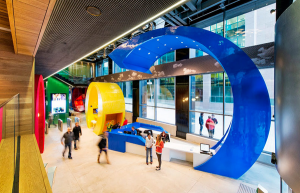 For those of you who missed our post last week, we used the Intuitive Compass® to create a Corporate Culture Questionnaire that is suitable for both CEOs trying to get a clearer understanding of how their company culture supports performance and for people in the process of looking for a new job who want to evaluate how well they would fit within the corporate culture of a particular company. (For those of you that need a primer on the Intuitive Compass, please click here.)
For those of you who missed our post last week, we used the Intuitive Compass® to create a Corporate Culture Questionnaire that is suitable for both CEOs trying to get a clearer understanding of how their company culture supports performance and for people in the process of looking for a new job who want to evaluate how well they would fit within the corporate culture of a particular company. (For those of you that need a primer on the Intuitive Compass, please click here.)
As promised, below is the decoding section for the quiz. You should have a score between 1 and 5 for each of the four quadrants of the Intuitive Compass: northeast, southeast, northwest, and southwest.
Northeast
The northeast quadrant highlights the administrative function. It shows how business is managed and organized. This is obviously an important aspect of business: how can an organization function well when processes are not well managed or are simply absent? Typically, a financial institution or accounting firm would score high in the northeast quadrant, whereas a startup may not be focusing on how to manage a business that is still being shaped. Therefore the important facts here are the nature and maturity of the business. Businesses with analytical functions at their core tend to score high in the northeast quadrant simply because organizational skills are in their DNA. Mature business tend to score high in the northeast quadrant because over time it becomes highly likely that systems and procedures have been put in place to ensure smooth operations that support continuation of the status quo. If a business is still young (less than 2 years old) it is naturally more adaptable; its culture is affected by the nature of the activity but can be influenced more easily because day-to-day activities are less ingrained with habits built over time. It is also important to evaluate the northeast in relationship to other quadrants; a low score in the northeast can sometimes be of lesser importance in a very high-performing culture (indicated by a high score in the southeast) or temporarily out of balance because the company is going through a major phase of reinvention of its business model, which brings more focus on the southwest and northwest.
Southeast
In the southeast quadrant, we have insights into the focus on performance and the measure of performance. A high score would be typical at a sales organization like a network marketing company. A low score would typically be found in a company focused on administration. This quadrant gives you insight into the level of emphasis that is given to results. If you are talented at working with metric objectives, regardless of your function in the company (marketing or sales), you will probably be inclined to seek a company with a high score in the southeast, like a sales oriented company. Conversely, if metrics are not your strength of interest, a company with a predominantly southeast culture is unlikely to make you happy or leverage your most valuable talents. In this case you may look for a company that is more about creation (southwest) and/ or administration (northeast). Again, the relationship with the other quadrants is key, especially the northwest and southwest quadrants. I know of highly profitable large consulting firms that have no sales objectives and no ongoing measure of their commercial performance: however, because they are very strong in the northwest (strategic planning), they deliver great ideas, and phone calls from new clients continue to come in.
Northwest
In the northwest quadrant we gather information on creative thinking and strategic planning. A higher score is always better, because as we saw earlier, research shows that openness to new ideas is a factor of longevity. However, a business may be extremely successful a few years in a row simply due to a series of great deals (southeast) and bold moves (southwest), without much strategic thinking involved. I’ve observed that a number of large companies tend to focus more on feeding the pipeline or following the “business as usual” routine strategy to meet sales objectives (southeast). Often companies focus on market opportunities to boost sales, with little thought about sustainable value creation, which leads them to not adapt their business model to today’s new market constraints and their marketing strategies to a new type of consumer; a dangerous path in the long run. So it is important to look closely at a northwest score and compare it with the score in the southeast.
Southwest
The southwest quadrant shows how much a company is dedicated to R&D and creation. This quadrant is crucial in the new economy. A high score in the southwest quadrant indicates a buoyant culture that can generate new ideas and creative initiatives and can support an entrepreneurial spirit. What can be problematic, though is a high score in southwest and low scores in the other three quadrants, as it would indicate a company where leadership and management are not well rounded and business functions are not well integrated. CEOs evaluating their own company should strive for a balance whereby creativity is supported from the perspective of both allowing and funding such activities as well as supporting the marketability of the innovations that are generated by developing strengths in the other three quadrants. Individuals evaluating the possibility of joining a particular company should also look for evidence of this balance.
From these results a number of conclusions can be drawn.
If you’re looking for a job, it is important to review the relationship between the culture of the company you are considering joining and your own Intuitive Compass® to determine whether it is a compatible match. For instance, if you are more of a southwest type of professional, you should really consider whether you’re being offered a position in a company that displays a northeast culture, and vice versa. These results are also insightful if you’re simply evaluating whether or not you should stay in the company you work for. I have a client, a C-level executive who realized that he would enjoy the southwest culture of a start-up much more than he did the very northeast/southeast culture of the multinational he had been working for since the beginning of his career. He finally decided to leave his job to create his own start-up: a consulting firm with a built-in incubator to launch new digital companies in the new media industry.
If you’re the CEO of a company and would like to improve the culture of your organization, analyzing the Intuitive Compass in relation to the culture of your company will lead you to identify areas for improvement in every quadrant where a score is low. You need to put the profile of your Intuitive Compass in perspective with your objectives and also your context at the time of the review: industry, market situation, mission of the company, corporate strategy. Each quadrant with a low score or any imbalance between the four quadrants represents an opportunity for growth. In addition, the Intuitive Compass can help you clarify and articulate to your teams the reason behind the new goals you may set for them.










